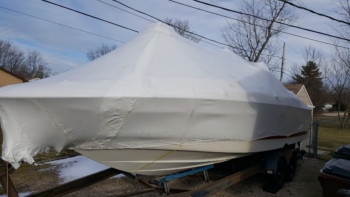In cold weather climates, boat owners worry about their engine freezing. When water freezes, it expands and will crack engine components.
It’s true that a boat engine will freeze. If you think the temperature is going to get sub-freezing, you need to protect your boat motor. While there are many circumstances that could come into play, an un-winterized boat engine can freeze and crack the block in a matter of hours.
Having a boat engine with a cracked block doesn’t stop it from floating, but it can stop it from running. You can have the block repaired or replaced, but it’s a lot cheaper to just prevent it from happening.
What Happens When An Boat Engine Freezes
When a boat engine goes unprotected from the freezing temps, it will sustain serious damage. First, and most likely, the engine block will crack. As the water left inside the “water cooling ports” of the engine begin to freeze, it expands. The water continues to freeze harder, but it can’t expand any further, until it breaks out the side of the engine wall.
This could happen anywhere along the cooling ports where water is present. It could break the engines heads, exhaust manifolds, block, etc. This is also true for your outdrive and plumbing system (if equipped).
Here’s a picture courtesy of ShipShape Marine that shows a badly cracked boat engine block. You’ll notice that it’s not a single crack, but rather many cracks as though it shattered. This is not repairable and the owner would have to find a replacement.

The next image, also by ShipShape Marine, shows an engine that sustained a freeze break, but the break appears to be a single, clean crack. This has the potential for a repair.

Can You Repair A Cracked Boat Engine?
Not always, as you can see in the pictures above. However, when you have a clean crack, repairing can be much cheaper than replacing. There are a few ways to do a crack repair on a motor. You can have it welded as the safest repair, but you can also DIY this repair on your own.
Depending on your mechanical abilities, you may be able to follow a few simple steps to repair the crack using epoxy. Many boat shops will suggest you have it welded or replaced because that’s the most sure repair (and they make more money this way). BUT, I have seen epoxy repairs that have been done many years ago and are still perfect.
I think it’s worth taking a little time to try this repair first, as it won’t prevent it from being welded later. Also this could save you thousands of dollars. I have used JB Weld and have had excellent results. Others prefer Marinetex or Belzona. Here is a Blezona video on how to use their product:
And Now My Choice Of Simple Engine Crack Repair
Here are the steps I took to complete a repair using JB Weld epoxy:
- Drain block of existing water by taking out the block drain plugs.
- Degrease the engine and then quickly spray it with carburetor cleaner.
- Drill a small (.125″ to .1875″) hole at the end of the crack, being sure there’s no crack beyond your hole. Drill until you “just” break through to the water port. This will stop the crack from continuing.
- Using a die grinder with a thin cut-off wheel, grind into the crack and penetrate approx .125″ to .1875″ deep, following along the entire crack. If you break through to the water port, don’t freak out. However, you will try not to break through.
- Now you will want to widen out the top surface of the grove you just made. You can do this by holding your grinding wheel perpendicular to the groove and following along it. You don’t need to go real deep with it, but you want a wider area at the surface ground out for better adhesion for the epoxy.
- Blow off all the grinding dust and spray out the grove with electrical cleaner spray or similar, as it leaves no residue.
- Now you’re ready to mix up your epoxy/JB Weld. Be sure you’re mixing up enough to fill up the void. Also use a slow setting epoxy and mix it a bit thick. You have one crack at this (pun intended)!
- Using a small brush or putty knife, apply the mixture into the groove. Be sure you are pressing it in enough to fill the void. Since the engine work surface is vertical, a thicker mixture is needed. Once you have the void filled, apply a good masking tape that is wide enough to reach .750″ on each side of the repair. Cover the entire repair and if needed, prop up a board over the repaired area also to keep the epoxy held in place during set time.
- Let everything set for 48 hours.
- Remove the tape and grind the repair area to be even and flush with the engine surface.
- If you’re happy with how it looks, then paint it with a matching “high heat engine paint” to finish it off.
Most likely you’ll have a repair that will last for many years if done correctly. You’ll also have saved your boating season and tons of money.
Options For Protecting A Boat Engine From Freezing
Most boat engines are cooled using water from the body of water that the boat is running in. The water is pumped from the lake and circulated through the engine, and exhausted back into the lake. This is unlike your car engine that has a pressurized and sealed cooling system with antifreeze.
The lake (fresh) water will freeze at 32 degrees Fahrenheit. Ocean water will freeze at 28.4 degrees Fahrenheit. By the time the temperatures are reaching within 10 degrees of freezing, you need to have your boat out of it’s slip and get freeze protection in place.
A few options to protect your boat engine from freezing are:
- Store the boat in a heated area (duh).
- Use an engine bay heater (not my first choice at all).
- Have the boat winterized.

Indoor heated storage is very expensive, and to me, doesn’t seem cost effective when considering the cheaper alternatives.
Using an engine bay heater is good for when you “get caught with your pants down” as the weather changes. However I feel that once you consider the cost of the heater and couple that with the cost of running the heater, it doesn’t make economic sense. You also run a high risk if the power goes out or the heater fails.
Your best option to protect your boat engine from freezing is to winterize it. You can either learn to do this yourself, or hire it to be done.
Winterizing Your Boat Engine
When I get really busy each fall, I’ll sometimes just have my boat mechanic come over and winterize my boats. This service costs me $200 which includes his travel time to my location, his labor, and all materials needed.
 What the boat mechanic did to my Monterey 268ss for $200 was:
What the boat mechanic did to my Monterey 268ss for $200 was:
- Stabilize the fuel.
- Pull the Propeller, check bearings and grease the prop shaft, then reinstall.
- Replace gear oil in the outdrive.
- Run the boat engine to open the thermostat and work fuel stabilizer through the system.
- Put 5 gallons antifreeze through the cooling system.
- Use fogging oil to protect the inside engine components.
- This boat has a couple sinks, a toilet, and a shower that also got treated with antifreeze.
I didn’t need him to do an oil change at that time, because it just had a fresh oil change. However, I did have him shrink wrap the boat for an extra fee of $280. I played with this boat too late into the season to get cheap indoor storage, plus I want access to it the second I get a nice day in the spring to start completing my work.
I hope you’re not faced with a cracked boat engine, but if you are, at least now you have some options and direction. I never had a motor freeze on my watch, but I have bought them this way. It’s not the end of the world usually, but can get quite costly if you hire out the repairs.
There is no better solution, than prevention. Read my article on how to winterize your boat yourself on the cheap. Even if you don’t winterize it yourself, you will at least know you can do it. So check out “Free Checklist To Prepare Your Boat For Extended Storage“.

